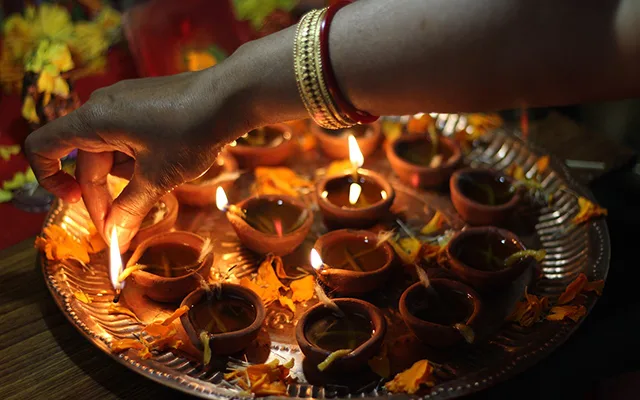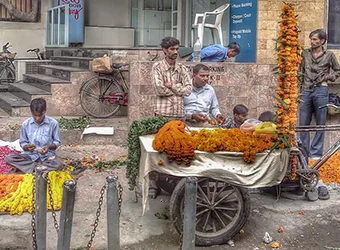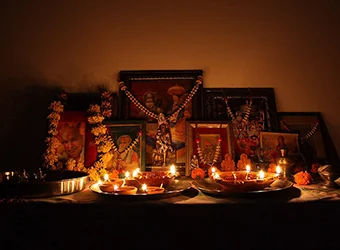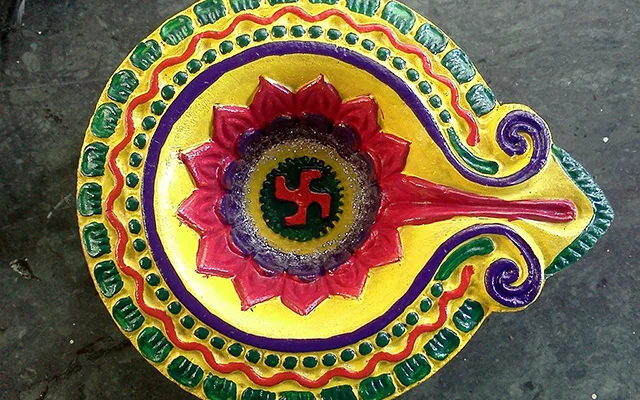What is Diwali & its' significance
Find out the deeper meaning of the Diwali Festival by exploring the roots and the historical aspects of this ancient celebration.

Diwali is a five-day celebration that is considered as the biggest and most important festival in India. It is celebrated by Hindus who represent 80% of India’s population, but it is also observed in various ways by Jains (0,4%), Sikhs (1,7%) and some Buddhists (0,7%). This fact defines the religious festival of Diwali as equivalent to a national holiday for India comparable to the Christmas celebration for the western countries.
The festivity that takes place annually during autumn, symbolizes knowledge, prosperity, and light, reflecting the victory of good over evil. Diwali derives from the Sanskrit word Dīpāvali that literally means “a row of lights”. More specifically, the compound term Dīpāvali comes from the words Dīpa that means “lamp, light or candle” and the word āvali that stands for “row, line, or series”. Indian communities embrace the festival by illuminating their homes with "diyas" (oil lamps), candles and artificial lights. They also worship the deities by offering prayers (pujas) and flame with the flame offering (aarti), while lighting up fireworks is also a central part of the celebration. This symbolic use of light as a metaphor for knowledge and consciousness makes Diwali to be mentioned as the Festival of Lights.
Diwali is an official public celebration in India and a great part of the working population has holidays during the festival. Schools and many businesses are closed, while many people are traveling in order to visit their family and friends. Tourism companies, attractions, and transportation are usually unaffected but they can have reduced opening hours of altered schedule. On the other hand, given that Diwali is related to gift exchanging, home decorating and new clothes, this period also marks the highest sale of the year for local markets, stores, and bazaars which are open during the whole festival.

When Diwali is celebrated?
Diwali is celebrated every year in early autumn between October and November. It is a movable festival that is observed exactly 20 days after the end of Navratri. Its celebration falls in the “new moon period” of amasvasya which is the darkest night of the Hindu lunisolar calendar. Thus, the five-day festive period starts two days before amasvasya and continues two days after, until the night that ends the lunar month of Ashwin and starts the month of Kartik. This time marks the beginning of the new year according to Vikram Samvat, the historical Hindu lunisolar calendar.
The lights of Diwali (row of lights) are lit just before the beginning of the new moon period. They are targeting to illuminate the darkest night of the year, to invite the presence of the deities and most importantly to celebrate a new beginning and honor the triumph of good over evil (metaphor, light over the darkness).
The celebration culminates on the third day of the five-day celebration which is also called "main Diwali". It is an official holiday for all India, while the preceding and following days are observed either as public or optional restricted-holiday in each corresponding state.

The ancient roots and the significance of Diwali
There is no doubt that Diwali is an identical part of Indian culture. It is the biggest and most important holiday in India since apart from Hindus, it is also observed by Jains, Sikhs, and Buddhists. Practically, through the years the festival gained a broader significance, thus all Indians regardless of their faith and background are participating in the celebration in a certain way.
It is an ancient celebration with a history over 2500 years and its religious significance is reflected through the numerous sacred texts and stories referring to that. Similarly to other festivals in the Hindu religion, it evolved through the years with continuous integration of multiple religious and cultural elements. A closer look at its origins reveals an astonishing mosaic of traditional narratives that have a meaningful role in Indian society.
Historical aspect

Many scholars argue that Diwali has its roots in the harvest festivals in ancient India. The timing of its observance, in early autumn, was a period when the farmers were finalizing their harvest and having less daily work to do, they were honoring the gods for the crops that mother nature was providing to them. Thus, from early times a series of harvest festivals were celebrating nature’s bounty that was coming after the monsoon period.
Sanskrit texts of the 1st-century mention a series of followed rituals were diyas (lamps) were symbolizing the sun which was worshiped as the cosmic provider of light and energy bringing fertility and life to nature. Later scripts from the 7th century mention the tradition of gift-giving to newly engaged brides and grooms who were about to expand their family by bringing their children to life. Different travelers from outside India who had the opportunity to observe the Diwali celebration describe the feast as a fusion of festivities that were honoring deities with countless oil lamps (diyas) illuminating their homes and temples. Participants are described as wearing beautiful and colorful garments and worshiping their gods with devoutness.
Religious aspect

As mentioned above, Diwali is observed by the followers of different religions in the Indian subcontinent. Consequently, there are various events, deities, and stories that are observed by different religious groups and among other regions of the country. However, the main message of the festival is the same for everyone since it portrays the symbolic victory of good over evil, knowledge over ignorance and light over darkness.
The regional differences regarding the rituals and beliefs related to Diwali may also have their roots in diverse local traditions connected to the observance of the old harvest festivals. This becomes clear from the fact that even among the Hindu population numerous variations can be noticed in the followed customs and traditions depending on the area or the state someone is visiting during Diwali.
